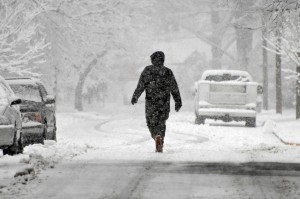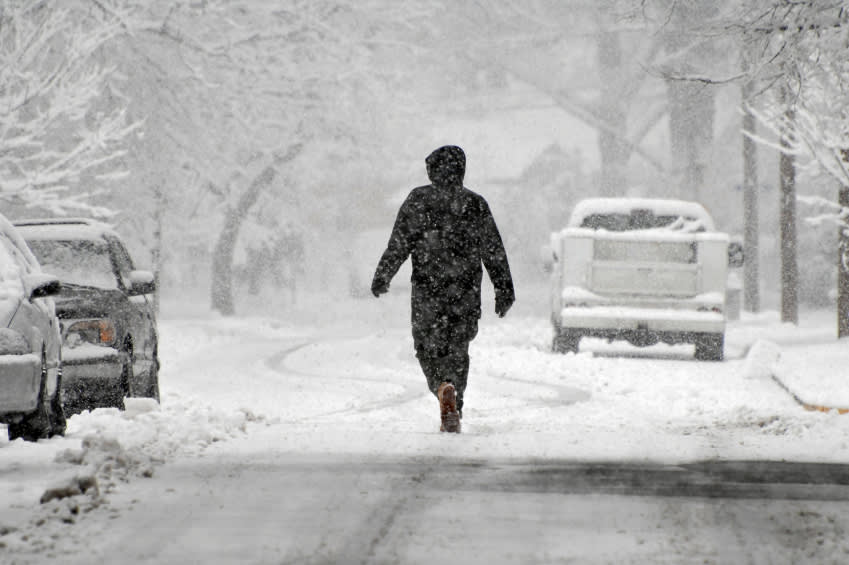Snow on Passover? It seems unheard of in many locations, but a snowy winter combined with an early Pesach and those attending seders in all but the tropical areas of North America may be in for a holiday like a very non-Jewish Irving Berlin song.
Typically, the festival occurs in early to-mid April, sometimes finishing in late April, but thanks to the formulation of the Jewish calendar, this year Passover will begin March 25 – earlier than it has been for the last 30 years and earlier than it will be for the next 30 years, if not more on both ends. (As another feature of this year’s early calendar, Jewish families can look forward to eating their Thanksgiving turkey near the light of the Chanukah candles; Thanksgiving is the second night of the holiday. And, of course, Rosh Hashanah begins two days after Labor Day.)

The odds of a White Passover are looking increasingly good, according to Craig Allen, chief meteorologist at WCBS 880 AM in New York. “Medium range (7-10 day) maps have a storm passing south of New York next Sunday, the 24th, but the next one comes right up and brings heavy rain/snow to the area Monday night into Tuesday,” he said. “The weather pattern is blocked in a cold pattern with no sign of it breaking down til the end of the month.” Meaning there’s a good likelihood children will be able to hide the afikomen in a pile of snow and Elijah will be shivering his way from seder to seder.
The last time a snowstorm hit New York at Passover time was 1982. (To be perfectly accurate, a light dusting did fall in Central Park in 1996 on one of the days of the holiday.) Twelve inches fell on April 5, 1982 and the holiday began on April 8. The snowfall was so heavy that the New York Yankees postponed their home opener and the burning of the chametz took place nearly knee-deep in the snow.
Jeff Feinberg, a member of the Orthodox Union’s accounting department, recalls walking to shul bundled up in his winter coat and snow boots.
“I couldn’t tell if it was Passover or Chanukah,” he said.
Avery Maron doesn’t remember the snowfall, but his parents certainly do. On April 6, 1982 his mother experienced labor pains and drove to the hospital from her home in Woodmere, Long Island. She gave birth that night and Avery spent his first seder with his mother snowed in at the hospital.
In northern climes, of course, snow on Passover is far more common than in relatively moderate New York. In 2011, according to children’s author Debra Darvick, a late snowfall hit Michigan. Writing on her blog at the time, she described it as the eleventh plague. “I pondered the plague of snow God might have sent had Pharaoh ruled Minnesota instead.”
Rabbi Daniel Friedman of the Beth Israel OU member synagogue in Edmonton, Canada said that snow is a regular feature of the holiday.
“There’s always still snow on the ground,” he wrote via email. The chill doesn’t dampen the festivities. The shul hosts a seder for 120 people and NCSY, the OU youth program, does the bedikat chametz (ritual search for leavened bread) followed by a pizza party in another location. The local water park has special men and women’s hours during the intermediate days of the festival – needless to say, the park is indoors.
Rabbi Baruch Taub, rabbi emeritus of the Beth Avraham Yoseph of Toronto Congregation in Thornhill, Canada, said that he recalled snowstorms heavy enough to create ideal winter sporting conditions. “I looked out my window and my neighbor was skiing to shul!” he said.
Of all the rabbis we spoke to for this article, we thought we’d leave Rabbi Chaim Goldberger of the Keneseth Israel Congregation of Minneapolis with the last word. He offered the most interesting interpretation of the effects of the weather on his congregation’s Passover experience.
Like many climes, Minnesota has four seasons, he wrote, “We just give them different names: Almost Winter, Winter, Still Winter and Construction.”
Passover tends to fall during ‘Still Winter’ each year,” he explained. “But the nice thing about ‘Still Winter’ is how it, at times, allows warmer weather to pass through the cracks. We have often been fortunate to have those nice weather days, when a sunny day just happens to coincide with a temperature thaw, pop out on the first days of Passover – as Hashem’s way of reminding us that He takes the name Chag HaAviv (Festival of Springtime) seriously. Almost invariably that will yield to a snowfall on the Last Days.”
However, he added, “It’s okay. We caught God’s ‘wink,’ and we know it will only be a little bit longer until ‘Construction.'”
Why is the secret of happy couples so important to religion? And what does it have to do with Pesach? Find out here.
The words of this author reflect his/her own opinions and do not necessarily represent the official position of the Orthodox Union.



